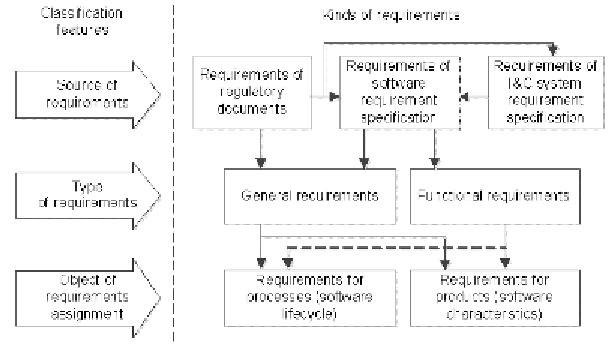Environmental Engineering Reference
In-Depth Information
reliability, stability, and processes (both develop-
ment and verification). The particular features of
this full set for software consist of:
For the first of them we can distinguish require-
ments of the regulatory (normative) documents
and requirements that are contained in the require-
ment specifications for development of I&C
system and development of software.
In the development of specifications for soft-
ware or I&C system (as a whole) requirements
of the regulatory documents must be taken into
account. Requirements of the specifications of
the software are developed with consideration of
the specifications for I&C system.
According to the type of requirement soft-
ware requirements are divided into general and
functional. General requirements do not depend
directly on what the functions are implemented
in I&C software, but are determined only by the
safety class, level of approval and its purpose.
Functional requirements depend completely
on the purpose of the I&C and tasks which are
solved by the software. The functional category
normally includes requirements for productivity,
synchronization, information protection, required
service lives, portability and so forth.
Depending on the object of assignment one
can distinguish requirements for software lifecycle
processes (development and verification) and
product requirements (software characteristics).
In the regulatory documents general requirements
1. Requirements for software as an element
of I&C system are determined based on
requirements for the I&C system as a whole.
2. Requirements for the structure in software
elements precede requirements for func-
tions. In this case we are speaking of general
requirements for software functions that are
important for safety, and not about functions
that are determined by its purpose.
3. Full set of quality characteristics we have
separated out one, which is most important
from the standpoint of safety standardiza-
tion, which determines the requirements for
monitoring and diagnostics.
4. Requirements for processes are determining
to a great extent, because they are expanded
and worked out in detail with consideration
of safety assurance.
In order to conduct classification for require-
ments we shall distinguish three features: source
of requirements; type of requirements; object of
requirements assignment (Figure 2).
Figure 2. Classification of software requirements

Search WWH ::

Custom Search